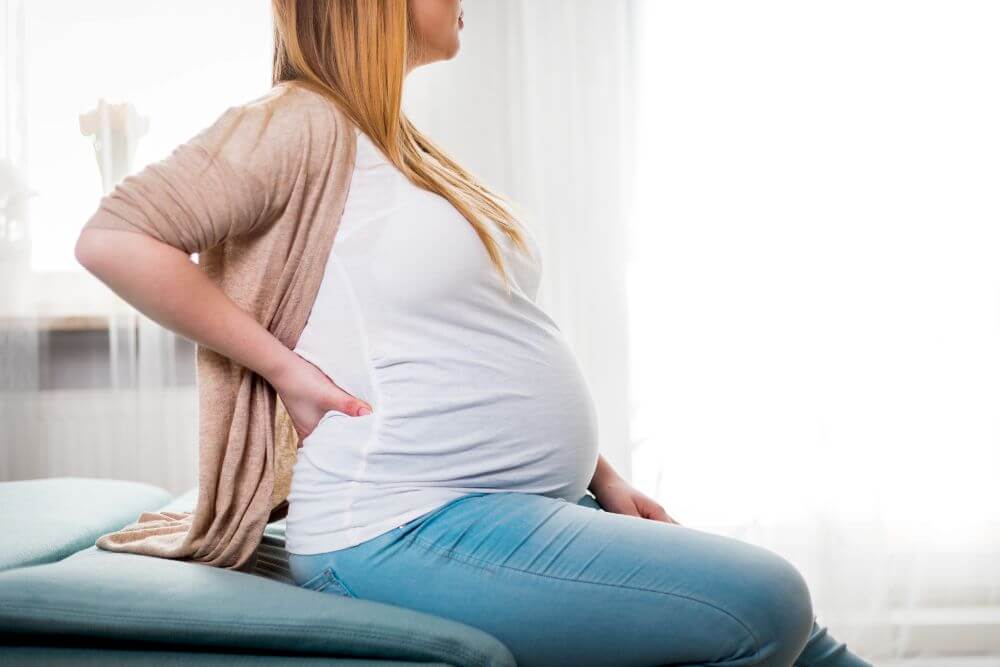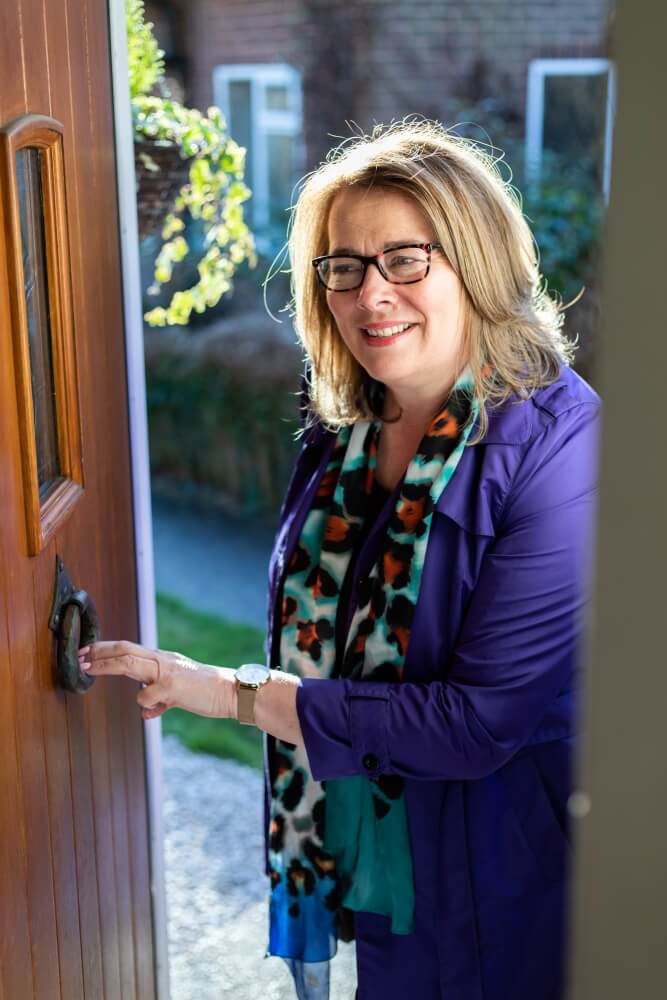
×

Between half and three quarters of all pregnant women have backache at some stage. But there are things you can do to ease the discomfort and stop it turning into a long-term problem.
WHAT ARE THE CAUSES?
Women tend to gain between 10kg and 12.5kg (22lbs and 26lbs) during pregnancy but nearly half of us gain more. This added weight is of course distributed mainly around the tummy which causes our centre of gravity to tilt forward.
To compensate for this, many women over-arch their lower backs and round their upper backs which can lead to backache.
Another cause of backache is the pregnancy hormone relaxin which relaxes the ligaments (the tough, flexible tissues that connect your bones), throughout the body.
As pregnancy progresses this hormone helps the pelvis expand to create more room for the baby, but it also relaxes the ligaments which forces the back muscles to work much harder. It’s hardly surprising then that backache is a common complaint during pregnancy.
HOW DO I KNOW IT IS A NORMAL PREGNANCY BACKACHE?
Backache in pregnancy can be divided into different categories. Back pain which is caused by the same factors as back pain in women who are not pregnant, pelvic girdle pain,sciatica or Piriformis syndrome
If you have suffered from back pain before becoming pregnant, it is much more likely to recur or get worse during pregnancy due to a combination of weight gain, poor posture and softening of the ligaments.
It often gets worse towards the end of the day or if you have been on your feet for a long time. This is because your muscles get tired and your ligaments stretch slightly from the weight of your body and baby.
Pelvic girdle pain
This is caused by a misalignment or stiffness of your pelvic joints which causes pain at either the back or the front of your pelvis.
The pain can be severe, making it difficult to get around, especially when walking or going up the stairs.
Getting diagnosed as early as possible is the best way to get pelvic girdle pain under control. Physiotherapy can help and you may be given a pelvic support belt.
It’s important to remain active but to avoid things that make the pain worse such as vacuuming or carry anything heavy. Try not to bend or lift, cross your legs or sit and stand for long periods.
Sciatica
Some women (fewer than 1%) will have sciatica during pregnancy. Sciatica is a pain that travels down the leg to the foot along the path of the sciatic nerve, which may be accompanied by pins and needles. It is not a medical diagnosis but refers to the pathway of the pain.
It is caused by irritation to the sciatic nerve or in some cases by a prolapsed disc in the lower spine.
Piriformis syndrome
This is when the Piriformis muscle irritates your sciatic nerve and quite literally gives you a pain in the butt !!. This usually responds beautifully to soft tissue release techniques and postural changes
WHAT CAN I DO TO PREVENT OR EASE MY BACKACHE?
Exercise:
Women who are as fit and flexible as possible before they become pregnant usually suffer less from backache.
If you are already pregnant, it’s never too late to improve your fitness. Weekly gentle exercise session will cut your chances of suffering backache, so why not do a google search for local pregnancy fitness or yoga classes.
Tightening your pelvic floor muscles and your tummy muscles will also help support your back.
A good exercise to do at home is to get down onto your hands and knees and level your back so that it is roughly flat. Breathe in deeply, then, as you breathe out, squeeze in your pelvic floor muscles and pull your belly button in and up.
Keep squeezing for between 5-10 seconds without holding your breath and without moving your back. Relax the muscles slowly at the end of the exercise.
Do this a few times (daily if possible) to strengthen your pelvic floor and back muscles.
If you are new to exercise go carefully and slowly to start with. Swimming is a great exercise during pregnancy as it takes the strain off the muscles supporting your tummy weight and also helps reduce ankle swelling. Find out if your local pool holds suitable aquanatal aerobics classes.
Check your posture:
Stand straight and imagine that someone is making you taller by pulling a string attached to the top and back of your head.
Doing an exercise called pelvic tilting can ease back strain caused by sitting or standing for long periods.
When standing, slowly work your pelvis back and forth, making your back round and then arched. Do these actions rhythmically without moving your shoulders. The exercise works best if you make it a habit before any pain comes on. If you have pelvic pain, focus on the forward tilt, as this helps your pelvis.
When sitting, ensure your hips and lower back are touching the back of the seat and your knees are at a 90º angle. It’s a good idea to place a cushion or a rolled up towel between your lower back and the seat.
Your back should always be well supported when you’re sitting down. Ideally, your back should be slightly arched with your breasts pointing straight ahead rather than down towards your bump.
Try parting your legs slightly so your bump has somewhere to go!
Sitting on an exercise ball prevents slumping and slouching, while also making pelvic tilting much easier to do.
Sitting upright in a dining chair will help your back more than lounging in a soft chair or sofa. If you have to sit for long periods at work try to get up and walk around every 20 minutes.
Massage:
Everyone loves a massage and it certainly soothes tired, aching muscles. Lean forwards over the back of a chair or lie on your side and ask your partner to gently massage your lower back and the muscles that run either side of your spine.
Linda our midwife at frombumps2babies is a pregnancy massage specialist trained in soft tissue therapy and she has a great reputation for relieving back pain in pregnancy with a mixture of massage stretches, an an instrument assisted massage tool
Don’t lift:
Try to avoid lifting, but if you have to lift or carry anything, hold it close to your body, bend your knees rather than your back and try not to twist.
If you have a toddler, get him to climb onto the sofa before you pick him up. Try to get older children to climb into their car seats by themselves.
Ask for help if you need it. If ever there was a time when people are happy to help you it is now!
Wear comfortable shoes:
This doesn’t mean you can’t wear heels. While flat shoes may seem more sensible in pregnancy a slight heel of around 18mm (¾in) is actually better for your legs and back.
When shopping don’t carry too much on one side. Divide your shopping into two equal loads and carry a bag in each hand. Better still, use a backpack – it’ll help your back muscles to work better (but get someone else to lift it onto your back, never twist and lift at the same time).
Sleeping
It is generally advised that you shouldn’t lie flat on your back for long periods of time, particularly after 28 weeks of pregnancy
By then, the weight of your baby can press on blood vessels and may make you feel faint. Try lying on your left, with your knees bent up and two or more pillows placed between your knees.
This keeps the pressure off the muscles around your hips and pelvis.
Placing a wedge-shaped pillow under your bump can ease backache. If your tummy sags down into the bed, try placing a small, rolled-up towel under your bump. Or you may find a special maternity pillow easier to keep in place.
Heat and water:
A warm bath, a hot water bottle or a warm jet of water from a shower head can ease aching muscles.
Support belts:
These take some of the weight of your baby off your tummy muscles and back. Ask your midwife for advice.
Kinesiotaping
During pregnancy, anything ingested can be transferred to the unborn child Because of this, most mothers-to-be try to avoid over the counter medications and prescription pain relievers to relieve their symptoms. Many, instead, opt for natural remedies to ease discomfort.
Kinesiology tape is a drug-free, safe alternative, that can help relieve many pregnancy symptoms including back pain, swollen feet, sciatica, carpal tunnel, and other aches and pains. Because of this, it is an ideal option for expectant mothers seeking relief from the ailments associated with pregnancy.
Made from cotton with an acrylic adhesive, k-tape is almost identical to skin in thinness and elasticity, allowing it to interact easily with the human body. The natural elasticity of the tape gently lifts the skin, allowing excess fluid to drain away and relieving pressure on pain receptors. It can be applied anywhere there is pain, swelling, spasm or weakness. When applied correctly, it begins working immediately and can continue to provide relief 24/7 for 3-5 days per application. Kinesiology tape is completely comfortable to wear and is also water resistant, so expectant mothers can wear it while showering, swimming or even exercising.
For most pregnant women, the ability to get continuous relief for several days can be a godsend. Being uncomfortable or in pain while pregnant can make sleeping difficult, and because kinesiology tape can be worn while sleeping, it can help provide much needed rest. And unlike pregnancy belts, which can be restrictive, uncomfortable and costly, kinesiology tape can offer similar support, while still allowing full range of motion at a much more economical price. Search google for a local pregnancy kinesiotaping preactitioner
WHEN SHOULD I SEEK HELP FROM A SPECIALIST?
If you think that you have more than the usual pregnancy backache or if none of these suggestions have helped ease your backache then see your GP who may be able to refer you to a specialist.
A registered, qualified physiotherapist, soft tissue massage therapist, chiropractor or osteopath may also be able to help.
Linda our Midwife at frombumps2babies has more information available if you have distressing back pain and she will share more resources with you at your massage treatment
Long gone are the days when fathers-to-be are left waiting in the wings to hear the announcement of their child’s birth by the attendant midwife or doctor. Instead, more partners than ever are playing an active role in the birth of their child. Birth partners are...
Let’s explore what affirmations are, how they help to prepare your mind for labour and birth and support you in accessing your bodies natural pain relief in labour.
So, the giddy excitement of discovering you’re pregnant has now been replaced with the reality & responsibility that you are actually growing a new life inside you which you want to protect and nurture at all costs. You might feel clueless about what to do next....

Linda Lilwall is a Private Midwife with over 30 years of experience and has helped welcome over 700 babies into the world.
She has a wealth of experience and is passionate about helping couples find their power as parents .
Her goal is to instil confidence through education and support, so that families are prepared for their journey into parenthood.
0 Comments